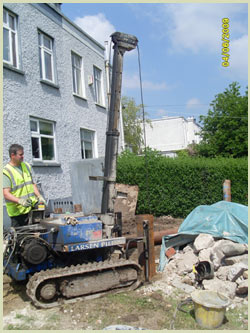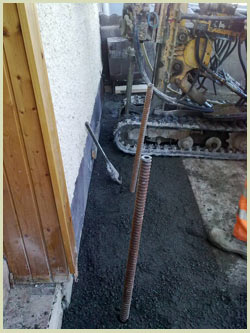Piled and Raft Foundations Design
There are situations where a less than favourable site assessment result is achieved. Filled ground or soft ground with a low bearing capacity such as silts, loose sands, peaty soil, or soft clays often require an engineered solution.
There are a number of options available:
- Raft foundations
- Piled foundations
- Deep strip foundations
- Pad and concrete beam foundation
- Vibro compaction
Regardless of the solution adopted it is advisable that this work is designed and supervised by an indemnified structural engineer who has experience of the various options available. The engineer will examine the layout of the building, quantifying and identifying load paths i.e. load bearing walls, piers, structural columns ,floor span direction etc. From this a reinforced concrete construction is designed to transfer load to the adopted support system.
For those who are unfortunate enough to have an existing property which is experiencing subsidence there are a variety of remedial solutions available. In these cases the engineer will also need to carry out a thorough site assessment, possibly with the assistance of a specialist soil investigation contractor. The first challenge is to identify the cause of the subsidence within the property and a good site investigation will assist in doing this.
Subsidence occurs most commonly as a result of weak or soft subsoil, leaky pipes, inadequately sized foundations or building on fill material. Subsidence can occur quickly with a dramatic effect or slowly over prolonged periods of time causing progressive damage to a building.
In many instances it may be adequate to provide remedial support only to the heavier elements within the structure i.e. load bearing walls, in more extreme cases internal floors and footpaths may also need additional support.


A wide variety of systems now exist to allow the provision of support in these cases. These include:
- Mini Piling:
Mini piling involves the use of small diameter steel piles which may be either driven or bored into solid ground beneath a building. A reinforced concrete pile cap or beam is then used to “pick” up the existing foundations, thereby transferring load to a suitable bearing stratum. Typically the piles are spread at 1 – 1.5m around the perimeter of the building and can operate in a few different ways, compression mini piles can be installed internally and externally, one either side of the foundation with a reinforced concrete ground beam spanning between ,or a compression and tension mini pile system installed externally using a cantilever reinforced concrete beam to support the existing foundation.
In choosing the right system for a given situation practical considerations such as space around the site, depth of existing foundation, cost and ground conditions all come into play.
- Pressure Grouting:
Pressure grouting involves drilling into the ground and the pressure injection of a liquid into the soil. Where soils are loose or containing significant voids the grout will flow under pressure to fill all spaces in the vicinity of a drilling. Once the grout sets it has a strengthening effect on the soil, increasing bearing capacity significantly.
Where suitable, this system can work extremely well being less expensive than the mini piling approach. In many cases the operation can be undertaken using hand held drills and small pumping systems. It is particularly useful where access presents a difficulty ,for instance when treating a terraced house or buildings of a similar nature.
- Resin Injection:
Resin injection techniques involve drilling into the ground beneath an existing foundation and injecting a chemical resin at depth. The resin then expands filling all voids as well as expelling air and water from the ground. This solution compacts the ground improving strength and bearing capacity.
Resin injection works very well in repairing large floor areas which have fallen victim to subsidence. As the resin material expands it can be used to “raise” a sunken foundation, pathway, floor or road. Through a process of monitoring using laser levelling equipment the operation can be undertaken in a controlled fashion giving excellent results in certain instances. Again, this system is cost effective and very suitable where access is tight.
- Traditional Underpinning:
Traditional underpinning of a foundation is possible where it is determined that the depth between the foundation and ground of good bearing capacity is shallow. It involves excavating initially to foundation level and then the removal and replacement of weak soil in a phased manner replacing with concrete.
The process is slow and not without risk and really only suitable where ground conditions are favourable and the extent of foundation needing support is not large.
